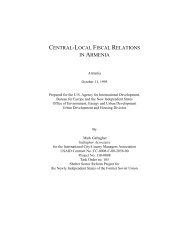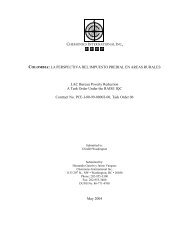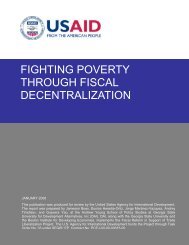Effectiveness and Economic Impact of Tax Incentives in the SADC ...
Effectiveness and Economic Impact of Tax Incentives in the SADC ...
Effectiveness and Economic Impact of Tax Incentives in the SADC ...
Create successful ePaper yourself
Turn your PDF publications into a flip-book with our unique Google optimized e-Paper software.
5-8 EFFECTIVENESS AND IMPACT OF TAX INCENTIVES IN THE <strong>SADC</strong> REGION<br />
cost. In this respect, rapid depreciation (up to a po<strong>in</strong>t) serves as a corrective measure ra<strong>the</strong>r<br />
than an <strong>in</strong>centive.<br />
Investment <strong>Tax</strong> Credits<br />
Zee, et al. (2001, p.1504) advocate <strong>in</strong>vestment tax credits (ITCs) as <strong>the</strong> preferred form <strong>of</strong> tax<br />
<strong>in</strong>centive. They note that an ITC is equivalent to an <strong>in</strong>itial allowance (IA) if <strong>the</strong>re is a s<strong>in</strong>gle<br />
company tax rate. 69 Hence, <strong>the</strong> two approaches generally “share <strong>the</strong> same advantages <strong>and</strong><br />
shortcom<strong>in</strong>gs,” as outl<strong>in</strong>ed above. If <strong>the</strong>re are multiple company tax rates, <strong>the</strong>n <strong>the</strong> ITC is<br />
more even-h<strong>and</strong>ed than <strong>the</strong> <strong>in</strong>vestment allowance. This is because <strong>the</strong> IA has greater value to<br />
companies that face <strong>the</strong> higher tax rate, companies that <strong>the</strong> tax system is designed not to<br />
favor.<br />
The OECD (2001) cautions that generous up-front <strong>in</strong>centives, such as <strong>in</strong>vestment tax credits or<br />
large <strong>in</strong>itial allowances, can endanger revenue by plac<strong>in</strong>g <strong>the</strong> beneficiaries <strong>in</strong> a large tax-loss<br />
position. This makes <strong>the</strong>m attractive c<strong>and</strong>idates for sale to companies with tax obligations, for<br />
<strong>the</strong> purpose <strong>of</strong> shelter<strong>in</strong>g <strong>the</strong> latter <strong>in</strong>come from tax. 70<br />
Treatment <strong>of</strong> Dividends<br />
To underst<strong>and</strong> how tax policy affects <strong>in</strong>vestment decisions, <strong>the</strong> analysis should exam<strong>in</strong>e rates<br />
<strong>of</strong> return from <strong>the</strong> po<strong>in</strong>t <strong>of</strong> view <strong>of</strong> <strong>the</strong> enterprise owners. This requires tak<strong>in</strong>g <strong>in</strong>to account<br />
<strong>the</strong> tax treatment <strong>of</strong> dividend remittances as well as <strong>the</strong> company tax. 71 With a classical tax<br />
system, bus<strong>in</strong>ess <strong>in</strong>come is taxed once at <strong>the</strong> company level <strong>and</strong> aga<strong>in</strong> when remitted to<br />
shareholders. The double taxation sharply <strong>in</strong>creases <strong>the</strong> effective tax rate. It also creates a bias<br />
<strong>in</strong> favor <strong>of</strong> debt <strong>in</strong>stead <strong>of</strong> equity f<strong>in</strong>anc<strong>in</strong>g, <strong>and</strong> dim<strong>in</strong>ishes <strong>the</strong> <strong>in</strong>centive to <strong>in</strong>vest. For<br />
example, suppose that <strong>the</strong> company tax rate <strong>and</strong> <strong>the</strong> <strong>in</strong>dividual <strong>in</strong>come tax rate are both 35<br />
percent. Then <strong>the</strong> effective tax on company <strong>in</strong>come, after remittance to shareholders, is 58<br />
percent. 72 Integrat<strong>in</strong>g <strong>the</strong> company tax <strong>and</strong> <strong>the</strong> dividend tax is <strong>the</strong>refore an important way to<br />
improve <strong>in</strong>vestment <strong>in</strong>centives <strong>and</strong> reduce <strong>the</strong> tax bias favor<strong>in</strong>g debt. 73<br />
The revenue effect <strong>of</strong> mov<strong>in</strong>g to an <strong>in</strong>tegrated tax system depends on how much revenue is<br />
collected on dividend <strong>in</strong>come. In most <strong>SADC</strong> countries, this is probably not a major source <strong>of</strong><br />
revenue. In any case, most economists view <strong>the</strong> <strong>in</strong>tegrated tax system as a normative<br />
st<strong>and</strong>ard. From this perspective, elim<strong>in</strong>ation <strong>of</strong> <strong>the</strong> double tax on dividends is an objective <strong>of</strong><br />
tax reform, not an “<strong>in</strong>centive” that should be counted as a tax expenditure.<br />
69 The equivalence is: ITC = IA x t, where t is <strong>the</strong> tax rate.<br />
70 When <strong>the</strong> United States exp<strong>and</strong>ed <strong>in</strong>vestment tax credits <strong>in</strong> <strong>the</strong> 1981 <strong>Economic</strong> Recovery <strong>Tax</strong> Act, one result<br />
was unexpectedly large revenue losses due to this type <strong>of</strong> tax-loss transaction.<br />
71 The treatment <strong>of</strong> capital ga<strong>in</strong>s also enters <strong>the</strong> equation here. See <strong>the</strong> essay on this topic by John K<strong>in</strong>g <strong>in</strong><br />
Shome (1995, 155-157).<br />
72 Given a pre-tax level <strong>of</strong> <strong>in</strong>come, I, <strong>the</strong> double stage tax creates an overall obligation <strong>of</strong> .35 I + .35 x (.65 I) =<br />
.58 I.<br />
73 Shome (1995, 149-155) conta<strong>in</strong>s excellent essays on <strong>the</strong> arguments for <strong>in</strong>tegrat<strong>in</strong>g <strong>the</strong> tax system <strong>and</strong> methods<br />
for do<strong>in</strong>g so.











